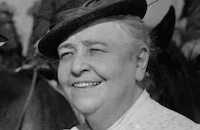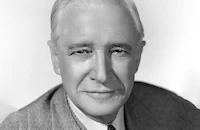Most Precious Thing in Life
Brief Synopsis
Cast & Crew
Lambert Hillyer
Richard Cromwell
Jean Arthur
Donald Cook
Anita Louise
Mary Forbes
Photos & Videos
Film Details
Technical Specs

Synopsis
In 1909 at Eastmore College, Bob Kelsey, a boy from a wealthy family, tells his parents that he plans to marry Ellen Holmes, a young woman from the lower class. After the couple are married they have a baby and name him Chris. Bob and Ellen live with the Kelsey family even though Ellen wants a home of their own. Because of the Kelsey's interference, Bob asks Ellen for a divorce. Wanting the best for her son, Ellen agrees to let the Kelseys rear Chris. Over the years she works at a number of menial jobs and eventually returns to Eastmore to work as a "biddy" or cleaning woman. In 1930, Chris, now a young man who believes his mother is dead, attends the college and he is assigned to a room that Ellen cleans. Ellen favors Chris and encourages him to join the football team. The semester ends and when the students return, Chris is assigned to a different building. Ellen persuades Carter, the head janitor, to change her building assignment, but when she asks the same favor a second time, in order to follow Chris when he changes his room again, she is fired. With the help of the dean's sympathetic wife, Ellen is rehired and assigned to Chris's building. Then, Ellen discovers a photograph of Patty, the daughter of her former roommate, Maggie O'Day, in Chris's belongings. Ellen warns Patty about the Kelsey family, but Patty remains steadfast and accepts Chris's marriage proposal. In hopes of breaking the couple's engagement, Bob invites Chris to travel with him for a year. When Ellen learns this, she confronts him and tells him that he has made their son into a cowardly, spineless snob. The next day, during the football game, after repeatedly fumbling, Chris flees the field and is met outside the stadium by Ellen, who tells him that he must not run from either the game or Patty. When Chris tells Bob that he will accompany him if Patty is allowed to join them, Bob reveals his true motive. Shocked, Chris and Patty leave together for a job in Chicago, far away from the Kelseys, and Ellen sees them off at the railroad station.

Director
Lambert Hillyer
Cast

Richard Cromwell

Jean Arthur

Donald Cook

Anita Louise
Mary Forbes

Jane Darwell
Ben Alexander

John Wray

Ward Bond
Dutch Hendrian
Paul Stanton
Greta Meyer
Arthur Rankin
Clifford Jones
Maidel Turner

Samuel S. Hinds
Ray Cooke
Tom Wallace
Nestor Aber
Lincoln Stedman
Christy Kellar
Cyril Ring
Andre Cheron
Buddy Messinger
Arnold Gray
Hal Greene
Robert "buddy" Shaw
Albert J. Smith
Beatrice Curtis
Carlyle Moore Jr.
Jimmie Barnes
Fletcher Norton
Alfred P. James
Clarence L. Sherwood
Loo Loy
Harry Strang
Harry Bowen
John Deering
Oscar Rudolph
Eddie Clayton
Heinie Conklin
Billie Van Every
Hal Price
Joan Dix
Frank Mcclure
Ila Lee
Peggy Leon
Mitchell Ingraham
Richard Kipling
Florence Dudley
Hope Holloway
Lenora Nova
Charles Hickman
Crew
Richard Cahoon
Earl Crowley
Lambert Day
Henry Freulich
Ethel Hill
Al Keller
Robert Margolis
Robert North
Homer Planett
Glenn Rominger
Dore Schary
John Stumar
Rod Tolmie

Photo Collections
Film Details
Technical Specs

Articles
The Most Precious Thing in Life
Arthur had been in films since 1923, when she signed a one-year contract with Fox after being discovered modeling in New York. She spent several dreary years in Hollywood, first at Fox, then at Paramount playing a succession of vapid ingénues and leading ladies in comedy shorts and low-budget westerns. With the coming of sound, her distinctive voice became an asset, but her roles did not improve. When her Paramount contract ended in 1931, the frustrated Arthur returned to New York and began working in theater. Impressed by Arthur's theatrical success, several studios offered her contracts, which she turned down. But she did agree to make one film, Whirlpool (1934), for Columbia, and eventually signed a long-term contract with the studio and returned to Hollywood. Whirlpool displayed a newly blonde, newly confident Arthur playing a quick-witted reporter. Although the film was a melodrama, her character offered the first glimpse of the vibrant Arthur screen personality, and the critics took notice.
The Most Precious Thing in Life, her third film at Columbia, was also a melodrama, and a somewhat heavy-handed one. But Arthur relished the challenge of playing a middle-aged charwoman, complete with gray wig and aging makeup. As she explained in a 1936 interview, "Some of our most famous screen actresses had done [similar roles], such as Irene Dunne, Norma Shearer, and Helen Hayes. I fought for the chance to do such a characterization....Unfortunately, for me, it was wrong." According to Arthur's biographer, John Ohler, "despite her sincerity in the role, the critics found her lacking in authenticity."
Disappointed, Arthur took off for New York to appear in another play. When she returned to Hollywood, she finally got the role that would be her breakthrough, in The Whole Town's Talking (1935), a rare screwball comedy directed by John Ford, which co-starred Edward G. Robinson in a dual role as meek clerk and his look-alike, a notorious gangster. That film showed off Arthur's talent for verbal comedy, and established the brash and sassy Jean Arthur character that would make the actress Columbia's top female star until the ascent of Rita Hayworth almost a decade later.
Director: Lambert Hillyer
Producer: Robert North
Screenplay: Ethel Hill, Dore Schary, based on a magazine story by Travis Ingham
Cinematography: John Stumar
Editor: Richard Cahoon
Costume Design: Robert Kalloch
Principal Cast: Jean Arthur (Ellen Holmes), Richard Cromwell (Chris Kelsey), Donald Cook (Bob Kelsey), Anita Louise (Patty O'Day), Mary Forbes (Mrs. Kelsey), Jane Darwell (Mrs. O'Day), Ben Alexander (Gubby Gerhart).
BW-67m.
by Margarita Landazuri

The Most Precious Thing in Life
Quotes
Trivia
Notes
Some contemporary sources list Robert Carlisle as editor instead of Richard Cahoon.














